When managing a House in Multiple Occupation (HMO), fire safety is one of the most crucial aspects to consider. Fire doors play a vital role in ensuring the safety of tenants by containing fire and smoke, preventing rapid spread, and providing essential escape time. Understanding the importance of HMO Fire Doors and complying with relevant regulations is not just a legal requirement but also a moral obligation for landlords.
What Are HMO Fire Doors?
HMO fire doors are essential for fire safety, designed to slow the spread of flames and smoke. They are typically rated as FD30 (30 minutes of fire resistance) or FD60 (60 minutes), providing tenants with crucial time to escape in an emergency.
These doors are installed in high-risk areas such as room entrances, kitchens, and shared corridors, ensuring compliance with fire safety regulations. Equipped with self-closing mechanisms, intumescent strips, and smoke seals, they automatically close and seal gaps when exposed to heat. Proper installation and routine maintenance are critical to ensuring their effectiveness in protecting lives and property.
Fire Door Closers: Are They Required?
Fire door closers are a legal requirement in HMOs, ensuring that HMO fire doors automatically shut after being opened to prevent the spread of fire and smoke. They must be installed on all fire doors within an HMO and should be tested regularly to ensure they function correctly. Depending on the property’s needs, landlords can choose between overhead closers, which are visible and commonly used, or concealed closers, which are built into the door for a more discreet appearance. Regular maintenance is essential to keep them in good working condition and ensure compliance with fire safety regulations.
Key Features of HMO Fire Doors
When choosing fire doors for an HMO, it’s essential to consider features that enhance fire safety and compliance.
Fire Resistance Rating – FD30 fire doors provide 30 minutes of fire resistance, which is the standard for most HMOs. In high-risk areas, FD60 doors offer up to 60 minutes of protection, giving tenants more time to escape.
Intumescent Strips and Smoke Seals – These expand when exposed to heat, sealing gaps around the door to block smoke and flames. Since smoke inhalation is a leading cause of fire-related deaths, these features are crucial for safety.
Self-Closing Mechanism – Fire doors should always close automatically after use to maintain fire barriers. This is a key requirement for HMO fire safety regulations and prevents doors from being left open accidentally.
Certified Installation and Maintenance – Fire doors must be installed by qualified professionals to ensure they function correctly. Regular inspections are also necessary to check hinges, seals, and door closers, ensuring they remain effective in an emergency.
Common Fire Door Mistakes to Avoid
Many landlords unknowingly compromise fire safety by making common mistakes with fire doors. Some of the most critical errors include:
Propping Fire Doors Open – Fire doors should always remain closed unless held open by an approved automatic release system. Wedging them open reduces their effectiveness in containing fire and smoke.
Using Non-Certified Fire Doors – Only doors that meet British safety standards (BS 476 or BS EN 1634) should be used in HMOs. Non-compliant doors may not provide adequate fire resistance.
Neglecting Maintenance – Fire doors must be inspected regularly to check for damaged hinges, faulty self-closers, and worn-out seals. Poor maintenance can lead to fire doors failing when needed most.
Incorrect Installation – Even the best fire doors will be ineffective if they are poorly fitted. A professional installer should ensure proper alignment, correct gaps, and secure fixings.
Ensuring Compliance with HMO Fire Door Regulations
To maintain a safe and legally compliant HMO, landlords must take proactive steps to meet fire safety requirements. Regular fire risk assessments should be conducted to identify potential hazards and ensure that all fire doors meet the required standards. Installing FD30 or FD60 fire doors in key areas, such as room entrances and escape routes, is essential for fire containment.
All fire doors should have self-closing mechanisms to prevent them from being left open, and intumescent strips and smoke seals must be in good condition to block smoke from spreading. Additionally, landlords should arrange for professional inspections at least once a year to confirm that fire doors are functioning correctly and remain compliant with legal regulations.
Conclusion
Fire safety should be a top priority for every HMO landlord. By installing compliant fire doors, conducting regular inspections, and following HMO fire regulations, you can protect your tenants and ensure your property meets legal standards.



































